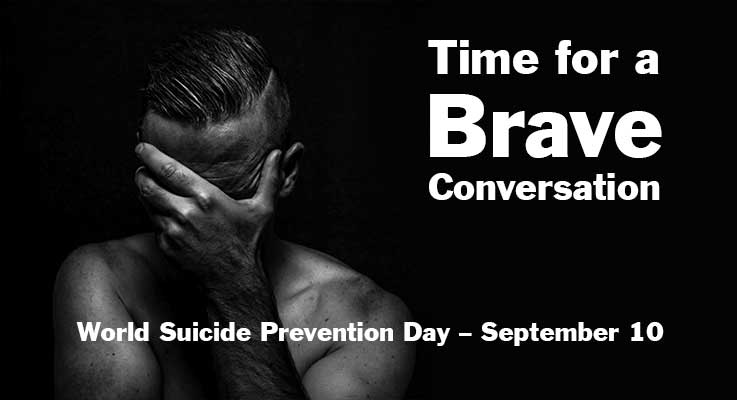
The COVID-19 pandemic, or more specifically the government’s shutdown of most sectors of our economy in response to the COVID-19 pandemic, is a monsoon drowning our country in hopelessness.
Hopelessness kills.
Hopelessness can spark a brief but intense period of despair, which may lead to a suicidal crisis.
An individual contemplates suicide when he or she loses hope in themselves, their future, and in the institutions that are supposed to help them.
That’s the situation far too many Canadians live with right now.
The government’s shutdown of the economy has far-reaching and disastrous effects for millions of Canadians, none of which are felt by politicians or government employees. Their paychecks continued, whether they showed up for work or not. They’re mostly immune to worst of the pandemic’s effects because the core need of all human beings – to keep a roof over their family’s head and food in their bellies – was never threatened.
Millions of Canadians aren’t so lucky.
World Suicide Prevention Day – Thursday, September 10th
To paraphrase The Beatles, we get by with a little help from our friends. This is true both before, during and after the current pandemic.
World Suicide Prevention Day is an opportunity for us to learn more about suicide and to raise awareness in those around us about suicide so we can, together, beat back the suffocating sense of hopelessness so many of us feel right now.
At a time when too many of us are contemplating a permanent solution (suicide) to a temporary problem (the pandemic), it’s critical for each one of us to make sure we, and those around us, are keeping our heads above the COVID-19 floodwaters.
The National Shooting Sports Foundation (NSSF), in partnership with the American Foundation for Suicide Prevention (AFSP), built a Suicide Prevention Toolkit[i] – a set of resources free for anyone who asks – specifically aimed at lowering the rate of suicides using firearms.
As a proud friend of the NSSF, the Canadian Shooting Sports Association encourages anyone, including gun owners, to ask for help when they need it.
How do we do this?
- By admitting we need help if we’re struggling
- By reaching out to someone who cares about us, someone we trust, when we’re in distress
- By keeping in regular, positive communication with those we care about to make sure they’re okay
Time and Distance Are Your Friends
Police officers and military veterans who have survived a gunfight will tell you that your two best friends in moments of intense danger are time and distance.
The same is true for suicide prevention.
If you or someone you care about is struggling with depression and hopelessness, the best way to prevent you or them from committing suicide is to put time and distance between you or them and the chosen method for suicide.
This can include temporarily removing access to a firearm, and there are many ways to accomplish this without jeopardizing your firearms licence.
The ability to get the help a person needs is critical, and by removing the fear of government intervention we remove what can be a major barrier to getting that help.
None of these options require police intervention, so the biggest fear many gun owners face, as we discussed in last week’s commentary, don’t apply – yet the individual is kept safe and can access the help they need.
Identifying At-Risk Family Members and Friends
Risk factors are characteristics or conditions that increase the chances a person may try to take their own life. They include, but are not limited to, the following.
Physical and mental health factors:
- Serious physical health conditions
- Chronic health issues, including chronic pain
- Depression
- Substance abuse
- Anxiety disorders
- Change in personality traits, such as rapid mood changes and aggression with no apparent cause
Environmental factors:
- Prolonged stress, such as the current COVID lockdown and harassment
- Financial crisis, like losing your job because of the COVID lockdown
- Divorce
- Death of a loved one
- Exposure to sensationalized/highly publicised accounts of suicides
- High-profile celebrity suicides
- Access to lethal means of suicide, including drugs and firearms
Take Warning Signs Seriously
Most people who attempt to or take their lives exhibit one or more warning signs, either through what they say or what they do.
When a person talks about one or more of the following, they may be at risk of committing suicide:
- Feeling hopeless
- Having no reason to live
- Feel trapped
- Feel they are a burden to others
- Being in unbearable pain
- Killing themselves
When someone you know is struggling, please
- Check in with them regularly to see how they’re doing
- Listen supportively to what they say
- Remember that you don’t have all the answers
- Help them find information and local support services but do not “take over” for them, even if they want you to, because this only reinforces their sense of helplessness
Help is Available
Search for “suicide prevention” and the name of the city where you live. This should provide a long list of resources ready, willing and able to help.
You can also search the Canadian Association for Suicide Prevention’s resource directory, located at https://suicideprevention.ca/need-help.
You can also call the National Suicide Prevention Service at 1-833-456-4566 or visit them online at https://www.crisisservicescanada.ca/.
Source:
[i] https://www.nssf.org/safety/suicide-prevention/suicide-prevention-toolkit/


Why did Toronto Mayor John Tory back off a city-wide handgun ban?